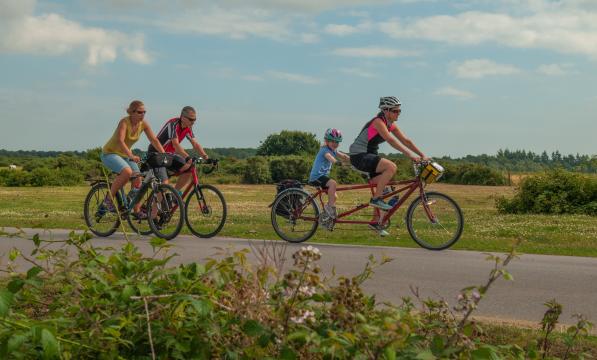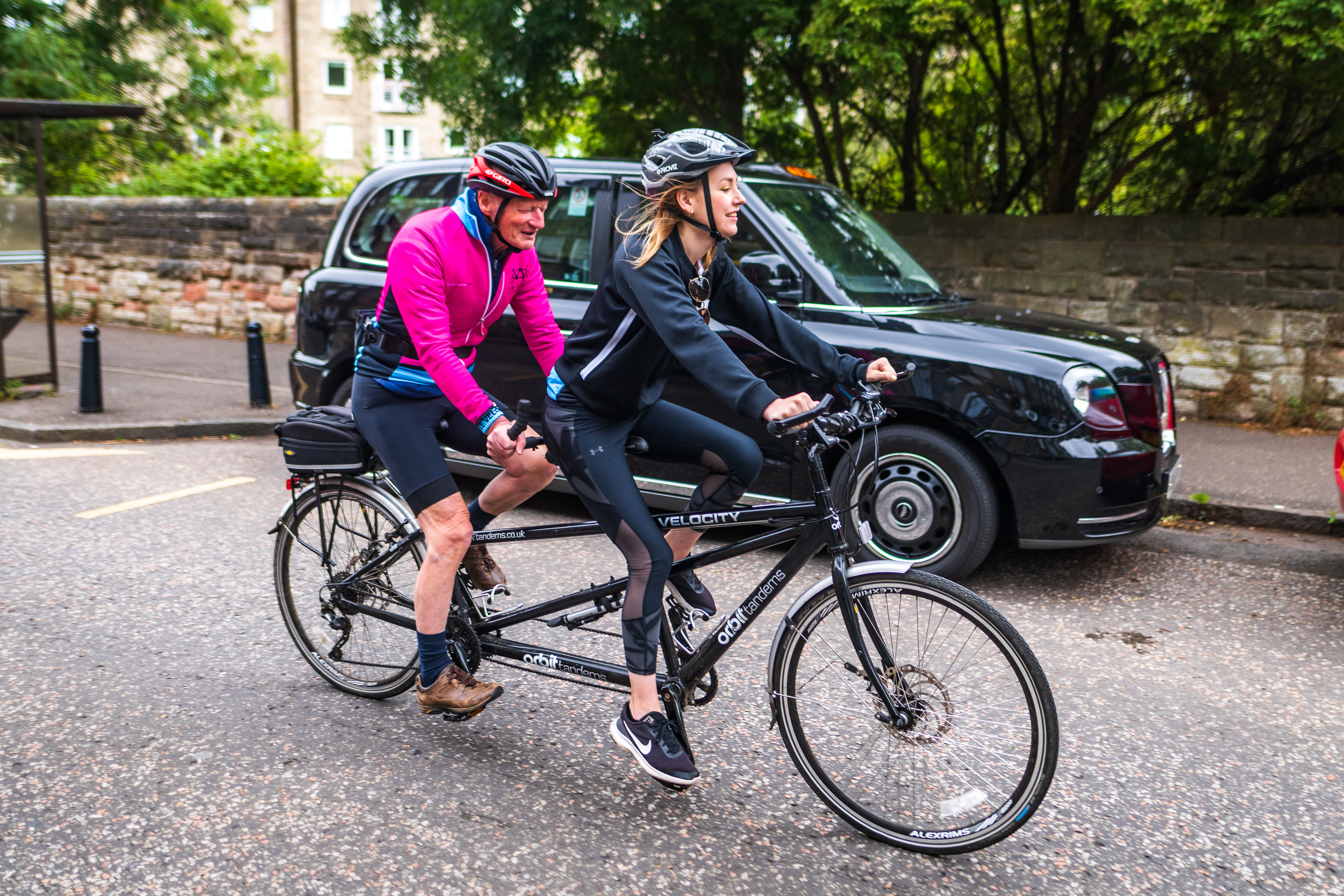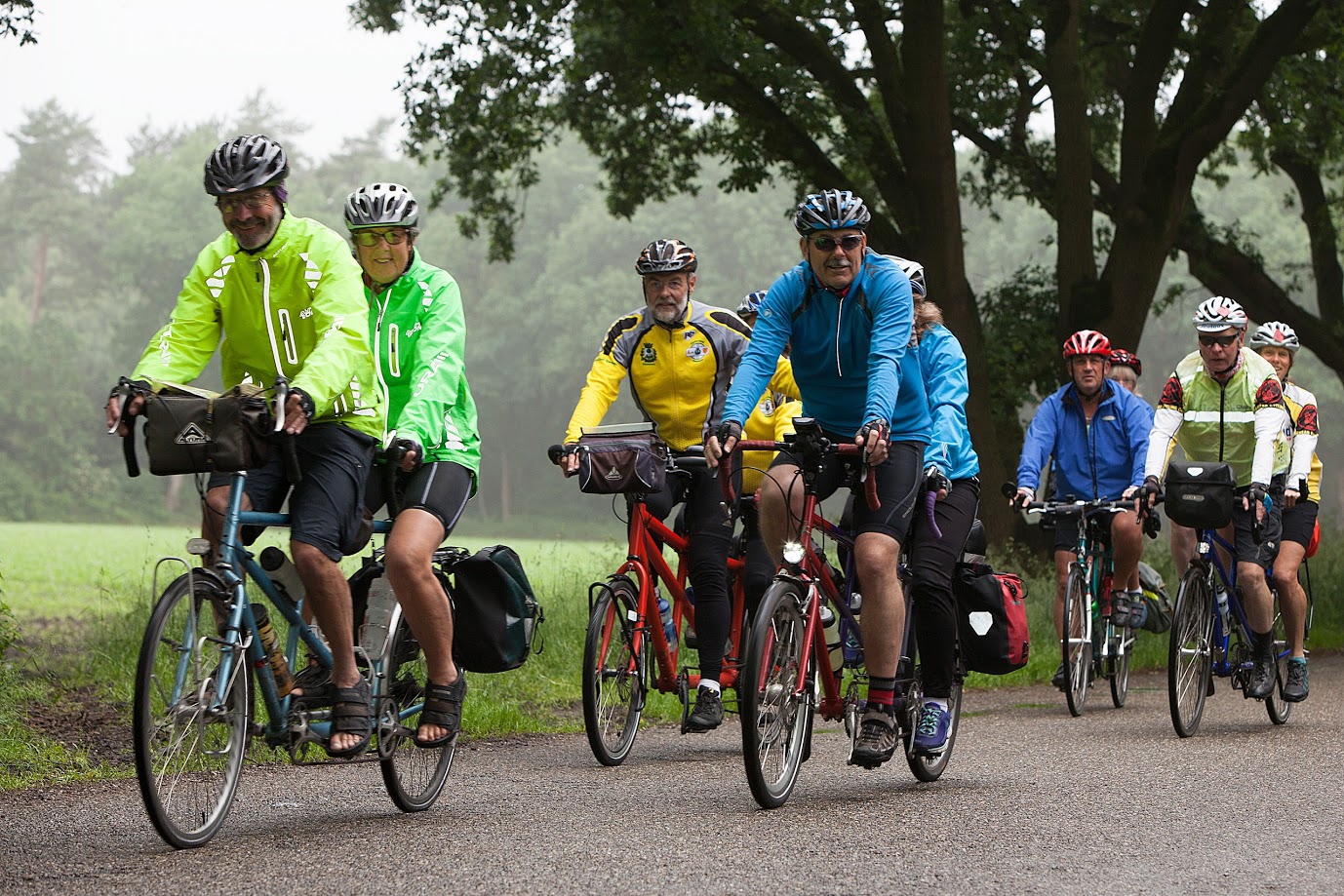Guide to tandems

Heading out on bikes as a family of different ages and different cycling ability can be problematic. Younger or less experienced riders risk getting left behind, while older children can get bored if they have to wait around.
A tandem lets two riders of different abilities cycle together without anyone getting left behind. It’s ideal for an adult and child.
The cost is a lot higher than for a trailer cycle, but it isn’t simply a luxury version – it can do much more. A tandem can be combined with a child seat, child trailer or even a trailer cycle so that a whole family can ride together.
Most tandems have two seats, one behind the other, although there are versions with three seats (called a triplet) or even more. The front rider – called the pilot or captain – controls the steering, the brakes and the gears. The rear rider – the stoker – helps to pedal.
Because of the extra weight and power on a tandem compared to a solo bike, it’s easiest to control if the heavier, stronger rider is the pilot – usually the man if husband and wife ride together, and always the adult if a child is onboard.
A tandem is the most efficient family bicycle, bar none. Two adults can go faster than one on a solo bike because, while you’re doubling the power, weight isn’t quite doubled (one tandem is lighter than two solo bikes), and wind resistance stays almost the same. This gives the tandem a big speed advantage when you’re going downhill, on the flat, or into a headwind.
Even with an adult and a child on a tandem, speed is barely less than an adult cycling alone.
If you’re touring, it means you can travel further. If you’re commuting, it means you have the option to step on it when running late!
Tandems don’t go up hills as quickly as solo bikes unless the riders can manage to pedal out of the saddle in perfect unison. Some can; most can’t. In that case, stick to pedalling while sitting down, shift to a lower gear, and accept that you’ll make up ground when you get over the brow of the hill.
Know your tandem
A tandem has to be built more sturdily than a solo bike, because it carries more weight over a longer frame. To stop it flexing from side to side as you pedal, an extra frame tube or two is usually added, running roughly along the bike’s torsional axis. That’s an imaginary line from the head tube, where the bike is steered, to the rear dropouts, which hold the rear wheel.
Some designs run a tube right along that axis, splitting it into an extra set of seatstays to reach the dropouts. Some run a tube from the head tube to the rear bottom bracket instead, and there are other variations on this theme.
A few designs ignore it entirely, but unless they incorporate massively oversized tubes the frame will flex with every pedal stroke. The heavier the riders – particularly the stoker – the worse the flex will be.

Tandems have two sets of pedals, with an extra chain (called the timing chain) running between. On some tandems the timing chain is on the left, on others it’s the right – either is fine.
As the timing chain isn’t kept in tension by a derailleur, another method is needed to stop it from going slack. This is achieved using an eccentric bottom bracket. Inside a bigger outer shell, the actual bottom bracket is offset in a circular housing.
Rotating the housing changes the position of the bottom bracket – a bit like the orbit of a coupling rod where it’s fixed to a steam engine wheel. This scope for adjustment allows you to take up the chain tension. Bolts on the outer shell allow the housing to be held in position when the chain is adjusted.
A tandem’s gearing is much like a solo bike’s, except that the range ought to be greater. Ideally a tandem needs gears that go as low as a mountain bike’s. It’s harder to dance gracefully on the pedals to get a tandem uphill as efficiently as a solo, and pedalling while sitting down requires lower gears.
Conversely, it also wants gears that go as high as those on road bikes, so that you can take advantage of a tandem’s superior power-to-wind-resistance downhill or on the flat. High gears aren’t so important, however, because you can always just coast coming down.
Reliable brakes are vital. For an adult and child, a V-brake front and rear is sufficient.
If you’re also carrying luggage or towing a trailer, it’s worth adding a drag brake – a kind of hub brake that’s designed to be held on during a long or steep descent to slow you down rather than stop you.
When two adults ride tandem, the stoker often controls the drag brake (or other third brake). With a child on the back seat, the pilot operates the lot.
Tandem wheels need to be stronger. How much stronger depends on you and your stoker’s weight. Some child-back tandems come with solo bike wheels, which is fine when you consider that an average adult plus one child only weigh the same as a heavy adult who might otherwise ride on the same wheels on a solo bike.

More spokes make the wheel stronger, and even on a child-back tandem 36 spokes (also used on solos) will be better than 32. Tandem hubs and rims are available that take 40 or even 48 spokes per wheel.
That provides valuable insurance against wheel damage if the tandem will be carrying more weight, whether in the form of heavy touring loads or a second adult. It’s particularly worthwhile in 700C wheels, which are about 10% weaker than 26-inch wheels.
A tandem’s tyres also need more pressure, to cope with the greater weight. Inflate them to the top end of the pressure rating on the tyre sidewall, even for a primary school-age stoker, and expect to exceed it with an adult stoker. Don’t worry: the tyres won’t explode!
A tandem can only carry the same number of panniers as a solo bike, so if you plan to take yours touring, or even shopping, make sure there are eyelets to fit a carrier rack at the front as well as at the rear. You’ll need it. If you’re camping, you may need a luggage trailer as well.
Child-back tandem
A child-back tandem is made specifically for an adult pilot and a child stoker. The top tube slopes down steeply from front to back, so that you can both have your saddles at the right height. Bike length is less too, since a child doesn’t need the same reach to the handlebars as an adult.
To an extent, a child-back tandem can grow with your child. A long seatpost is required, of course. Also useful is a telescoping stem for the stoker handlebars, so they can be moved further away as the years pass.
Some tandems have ‘double-drilled’ cranks. That is, there are two pedal holes in each crank: one closer to the bottom bracket axle for smaller children, and one further away for larger children. When the time is right, you unscrew and refit the pedals.
The main benefit of a child-back tandem over an adult tandem is that everything is scaled for your child from the start; you don’t have to customise it. With the rear saddle so low down, your child will be able to get on and off without your help, too.
Since the whole bike is a bit smaller, it’s a little easier to live with than an all-adult tandem: easier to store and easier to get in or on a car.
A few custom frame builders are well known for their tandems and will readily make child-backs for a four-figure sum. Names to look for include: Longstaff Cycles, Bob Jackson Cycles, and Mercian Cycles.
For rather less outlay, you can get an off-the-peg child-back tandem. The Thorn Voyager is a great bike for the price and features 26-inch wheels with a touring/utility steel frame, slick tyres and decent-quality mountain bike gearing.
Some tandems aren’t made for a child stoker but would nevertheless fit because the seat will go low enough for a child to reach the pedals. The reach may be too great, in which case you will need a longer or telescoping stoker stem.

Adult cranks are too long for children. An engineer who is able to cut down cranks to suit a child can alternatively drill another pedal hole, which will allow two pedal positions – adult or child.
Another interesting option is the Bike Friday Family Tandem, a small-wheeled tandem that fits a child or adult stoker – and packs up into a couple of suitcases! The now out-of-production Bike Friday Family Triple Traveller was a three-seater version of the same bike, with the middle seat meant for a child and the rear for an adult or a child.
You can only get such bikes to order in the UK. Try contacting Avon Valley Cyclery or Cycle Sense.
Adapting an adult tandem
Lowering the child down to the pedals via a child-back tandem isn’t the only option. If you’ve already got an adult tandem – or would prefer to buy one so that you can convert it back again when your child is bigger – the pedals can come up to reach the child.
So long as you’ve got a good level of mechanical competence, this is a conversion you can do yourself. If not, it’s a job for your local bike shop.
What you need are kiddie cranks. These are: a bottom bracket that bolts to seat tube under the child’s saddle; a child-sized chainset; an extra timing chain; and an extra chainring for the tandem’s drivetrain to link the child’s chain into the loop.
You could saw up an old bike to get the bottom bracket. An easier way to is to buy it: St John Street Cycles sells a kiddie crank seat tube block. Get yourself a 110mm chainset while you’re at it. You’ll then need to add a chainring to the tandem’s main drive, ideally no bigger than the child’s or you’ll spin their legs like egg whisks.
It’s easiest to add a chainring to the right-hand side of the pilot’s chainset – using a new single ring right-hand crank if the timing chain is on the left, or a new double or triple-ring crank in place of the existing single if the timing chain is on the right.
It’s also possible to run the child’s timing chain to the pilot’s left-hand crank or to the left-hand stoker crank; the latter is neatest.
Get a tandem specialist to advise – try JD Tandems, Longstaff Cycles or SJS Cycles. Once you’ve bought a new adult crank and a new chain or two, the conversion will cost something over £100 – more if you use more expensive components.
That’s not quite it. You also need to let your child reach the handlebars. A long stoker stem and backswept stoker bars is one option. Another solution requires a bit of DIY but arguably works better for smaller children.
You will need: two pairs of drop handlebars; an extra stoker stem; two broom handles; lots of handlebar tape.

Fit one pair of drop bars in the normal stoker stem, upside down, bar ends pointing backwards. Fit the other stoker stem pointing back from the child’s seatpost, and in that fit the other pair of drop bars, also upside down but with the ends facing forwards.
Saw down a broom handle so that it is several centimetres longer than the distance between the bar ends and wedge one end in each bar end, if necessary wrapping the broom in insulation tape to provide a tighter fit. Repeat with the other handle. Your broom handles need to be roughly the right diameter. Take your drop bars to the hardware shop to check.
When you’ve done this, tighten all bolts and wrap the lot in handlebar tape. Your child will have handlebars all down each side and can hold on anywhere.
As your child grows, you can lower the kiddie crank attachment block down the seat tube and/or raise the saddle. And one day you can remove the whole caboodle and be left with a standard tandem.
Can you ride tandem?
Riding a tandem is easier than riding a solo bike plus trailer cycle. The long wheelbase of a tandem makes is very stable, although the slightly bus-like cornering at slow speed takes some getting used to.
There is very little ‘tail wagging dog’ as the child’s weight on a tandem is between the steering bike’s axles rather than way behind them, as on a trailer cycle. The restriction on weight only exists insofar that the pilot be heavier than the stoker – and even that’s not vital.
The stoker has to trust the pilot completely and not try to steer the bike or tense up. That’s more of a problem with adults than it is with children, who are both more trusting and a lot lighter!
Once you’re moving, both riders are chained together and have to pedal simultaneously – even if that means you pedalling and dragging the stoker pedals around too. Inexperienced adult tandem riders may struggle to synchronise their pedalling efforts effectively.
Again, it’s easier with a child stoker. Since you’re so much bigger and stronger, you set the tempo and your son or daughter can join in or go through the motions as desired.
The thing to watch for with a child stoker is his or her feet coming off the pedals. If you don’t notice immediately, the pedals will come round again and whack dangling legs. Use toe clips to keep little feet in place.
The hardest part of tandem riding is starting and stopping, particularly for two adults. To get on, the pilot straddles the bike, feet on the floor, holding the brakes on. Leave the left-hand pedals at the bottom of the stroke, so that the stoker can use the rear left pedal as a mounting step to get onto the saddle and ready to go.

This ensures the stoker won’t spin the pedals backwards when stepping on, which could spin one of front pedals into one of the pilot’s shins. Ouch!
With the stoker on board, you can roll the bike forward to put the right-hand pedal over the top of the stoke, ready to tread down onto, setting off and simultaneously rising up onto the pilot’s saddle. That’s the theory anyway.
Two adults will need some kind of signal to start pedalling simultaneously. With a child stoker, it’s easier: you can just announce you’re setting off and go – you’ll have enough mass to get the tandem rolling by yourself.
This procedure works with a child stoker who is tall enough to get onto a child-back tandem and able to worm feet into toe clips unaided. If you’ve got a smaller child or a taller bike such as an adult tandem with kiddie cranks, it’s a bit more complicated, because you have to get your child on first.
It’s much easier if the tandem has a drag brake – which can be left switched on – and a rear carrier rack. You can then put the drag brake on, straddle the rear rack, and hold the bike steady with your thighs.
Lift your stoker onto the saddle and slot feet into toe clips. Then, never forgetting to hold onto some part of the bike at all times, you need to work your way to the front and step over the top tube. Do not swing your leg over your saddle: you will kick your stoker in the head.
Alternatively, you can straddle the front of the bike, facing towards the back and holding the top tube between your thighs. Again, switch on the drag brake if you have one. Now reach down and lift junior onto the saddle.
To get going, you just have to step off the bike and back onto it facing the right way, at all times holding some part of the bike such as the pilot’s saddle and/or handlebar.
To get off, you put your feet down and reverse whatever procedure you used to get you both on.
Tandem tips
- Talking is easier on a tandem because you’re much closer together, so the ride is more social. Plus it’s more egalitarian: a child on a tandem is more of a partner in the cycling experience than the trailer cyclist, who really is ‘tagging along’. The general tips for riding with a trailer cycle also apply to tandems. Keep an eye out for your stoker getting drowsy – perhaps with a mirror?
- There are lots of combinations to get families mobile. Tandem plus trailer cycle. Adult-sized triplet with kiddie cranks in the middle and a child seat behind the rear stoker. I used a Thorn ‘Me’n’U2’ double child-back triplet. This out-of-production bike may be available secondhand.
- Finally, don’t forget that tandems are harder to transport than solo bikes. You’ll need a special roof-rack adapter for your car, such as the Pendle Tandem Carrier (from £200). Some intercity trains will accept tandem bookings; most trains won’t.
If you want more information or inspiration, consider joining the Tandem Club, which was founded by Cycling UK/CTC members in 1971.








